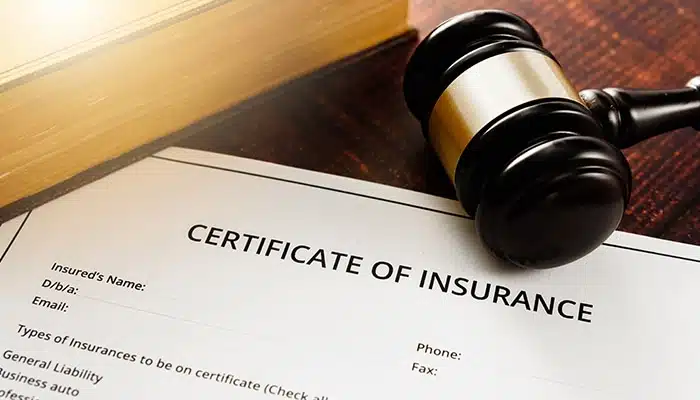
1000+
customers

50+ countries
across the world

Outsourcing leader
since 2008

Technology-driven
services

Stringent
quality processes
Certificate of Insurance: Everything You Need to Know
Last updated: 25 Jan, 2024 By Mohit Sharma | 6 Minutes Read

Certificates of Insurance (COI) are legal documents of proof of an individual or entity’s insurance coverage. These certificates, used in business transactions and contracts, serve as evidence to verify that the insured party has the necessary insurance protection. They are typically issued to a third party, known as the certificate holder.
Certificates of Insurance outline essential details such as the policyholder’s name, policy number, coverage type, effective dates, and any additional insured parties. Well managed COIs mitigate risks and liabilities for all involved parties. This they achieve by ensuring that adequate insurance is in place. The certificates actively contribute to facilitating smooth business operations by ensuring effective risk management and compliance with legal and contractual obligations
What is a Certificate of Insurance?
The certificate of insurance is a document providing evidence that certain general types of insurance coverages and limits have been purchased by the party required to furnish the certificate.
— International Risk Management Institute
Why Certificate of Insurance Matter?
Certificates of Insurance have a crucial role to play in business transactions and contracts – they address key aspects of risk management, liabilities, and legal compliance. Let us take a closer look at their importance in these areas:
Importance in business transactions and contracts:
- Verification of insurance coverage: COIs for businesses are quick and standardized mechanism for one party to verify that the other party has the necessary insurance coverage as required by the terms of a contract or agreement
- Risk assessment: Businesses, in the regular course of conducting their day-to-day operations, usually make transactions that involve potential risks and liabilities. COIs help in assessing and understanding the level of insurance protection required to be taken in order to keep all parties safe of undue losses. The certificates give confidence to all parties involved
Mitigating risks and liabilities for all involved parties:
- Risk transfer: By requiring a COI, the requesting party (certificate holder) seeks to transfer or share certain risks and liabilities with the insured party (policyholder). This ensures that potential losses are covered by the insurance policy rather than becoming a financial burden on the certificate holder
- Protection against unforeseen events: COIs provides both protection and financial security to the business parties. In the event of accidents, property damage, or other covered incidents, it is the existence of insurance coverage as confirmed by the COI, that helps mitigate financial and legal risks for all parties
Ensuring compliance with legal and contractual obligations:
- Contractual requirements: Many contracts and agreements stipulate specific insurance requirements that must be met by one or more parties. COIs meet this requirement of documentary evidence offering proof that the requirements have being fulfilled. It ensures compliance with the terms of the contract
- Legal protection: In some cases, non-compliance with insurance obligations specified in a contract may lead to legal consequences. COIs help parties demonstrate their adherence to these obligations, offering legal protection and reducing the likelihood of disputes
Facilitating smooth business operations:
- Smooth contract execution: A valid and up-to-date COI will always expedite the execution of contracts. After all, it provides assurance to all parties involved. And eliminates the need for time-consuming negotiations or concerns about the financial stability of the other party in case of unforeseen events
- Project funding and lending: COIs are often required by lenders or investors as part of due diligence processes. A COI confirms the presence of a comprehensive insurance coverage. It, therefore, influences financing and lending decisions positively
Best practices in Certificate of Insurance management
Certificate of Insurance management is as crucial as taking the insurance. Well managed and well tracked Certificate of Insurance systems help businesses with compliance, reduces their risks, and improves their overall efficiencies. Let us analyses few best practices in Certificate of Insurance management:
Establish a streamlined COI tracking system:
- Maintain a centralized database: Maintain a centralized and easily accessible database or software system for tracking the Certificates of Insurance. This will helps in organizing and retrieving information easily when required
- Implement an automated notification system: This will be able to send notifications for upcoming policy expirations and renewals, thereby ensuring timely updates
Regularly update and verify Certificate of Insurance for accuracy:
- Schedule regular reviews: This will ensure that the Certificates of Insurance are up-to-date and accurately reflect the current insurance coverage
- Policy endorsements: Pay attention to any policy endorsements or changes that might affect coverage. Regularly request updated Certificates of Insurance to reflect these modifications
Communication and collaboration between stakeholders:
- Clear requirements: Clearly communicate insurance requirements in contracts and agreements. Ensure that all parties understand their responsibilities regarding the Certificates of Insurance
- Open communication channels: Foster open lines of communication between the certificate holder, policyholder, and other stakeholders. Encourage prompt reporting of any changes in coverage
Outsource Certificate of Insurance management:
- Third-party services: Consider outsourcing Certificate of Insurance tracking and management to specialized third-party services. These service providers can efficiently handle the verification and documentation process, freeing up internal resources. They can also provide a wide range of other advantages including cost arbitrage, efficiency across functions, access to domain skills, increased productivity, and flexibility
- Risk assessment: Third-party services often also provide additional insights and risk assessment capabilities, helping businesses make informed decisions
Chart clear document retention policies:
- Record keeping: Develop and adhere to a document retention policy that outlines how long Certificates of Insurance and related documents should be kept. This will ensure compliance with legal and auditing requirements
- Organized filing: Maintain an organized filing system for both digital and physical copies of the Certificates of Insurance. This will facilitate quick retrieval when needed
Conduct periodical training and education:
- Stakeholder training: Provide training to relevant personnel on the importance of Certificates of Insurance, their verification process, and the overall impact on risk management
- Standard Operating Procedures (SOPs): Develop clear SOPs for requesting, reviewing, and documenting the Certificates of Insurance. Standardization will help in maintaining consistency
Integrate with other systems:
- Integration with contract management: If possible, integrate your Certificates of Insurance tracking system with other business systems, such as the contract management platforms. This will ensure seamless coordination between different aspects of business operations
- Enable data sharing: Data sharing between departments responsible for insurance compliance and risk management will promote a holistic approach
Conduct regular audits and assessments:
- Periodic audits: Conduct periodic audits of the Certificates of Insurance management process to identify slack areas. This will drive improvement and the easy identification of potential risks
- Performance metrics: Establish key performance indicators (KPIs) to measure the effectiveness of Certificates of Insurance management practices and make adjustments as needed
Cogneesol’s automated Certificate of Insurance process – a case study
The client, one of the largest commercial insurance agencies in the USA, faced challenges in timely Certificate of Insurance (COI) issuance due to non-standardized processes and multiple stakeholders. Cogneesol’s coi optimization solution focused on standardizing input collection, initially facing resistance but later integrating a two-phase automation approach.
In Phase I, manual data entry into a common database was automated using Robotics Process Automation (RPA), while Phase II involved an artificial intelligence (AI) tool extracting relevant data from various sources. The results were significant — a 68% reduction in turnaround time, 42% improvement in productivity, COI issuance within 10 minutes, and a ~5% enhancement in on-road time for the cover holder. The client credits Cogneesol for providing enhanced technology and automation capabilities, enabling future growth opportunities.
The future of Certificates of Insurance
Certificates of Insurance require a robust regulatory framework. In a situation where this is absent, there will be a likelihood of fraud risks, leaving clients vulnerable to inaccuracies and inconsistencies. As we firmly move into a tech-driven world, automation, blockchain, smart contracts, data analytics, digital platforms, interoperability, and digital identity verification will drive the future of COIs. These will streamline COI lifecycles, minimize manual errors, provide secure, transparent record of insurance transactions, enhance the integrity of the COI ecosystem.
In addition to technological advancements, insurance BPO services have the capability to further strengthen the future of Certificates of Insurance. Today, BPO providers have pivoted into the world of automation, offering specialized solutions for COI management. They are also experts at handling administrative tasks, data validation, and adherence to evolving regulatory standards. These value offerings are important for insurers for the smooth operations of their business functions, and also for their growth and expansion. Outsourcing, therefore, will drive significant value.
Latest Blogs

This site is protected by reCAPTCHA. Google's Privacy Policy
and Terms of Service apply.









